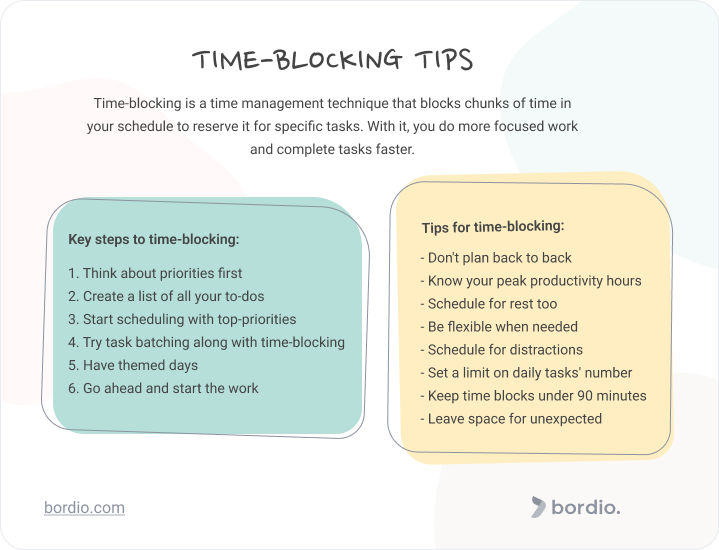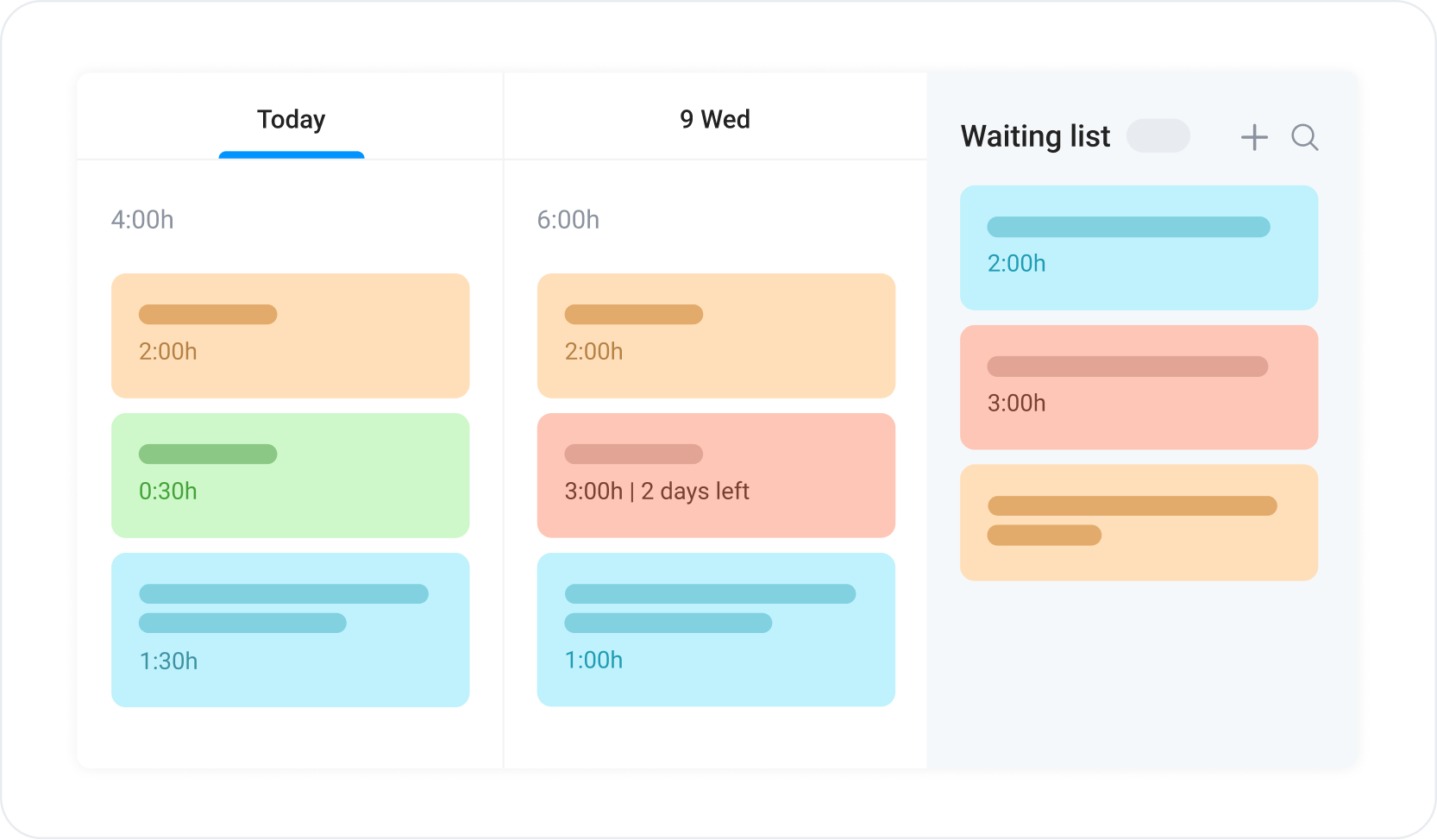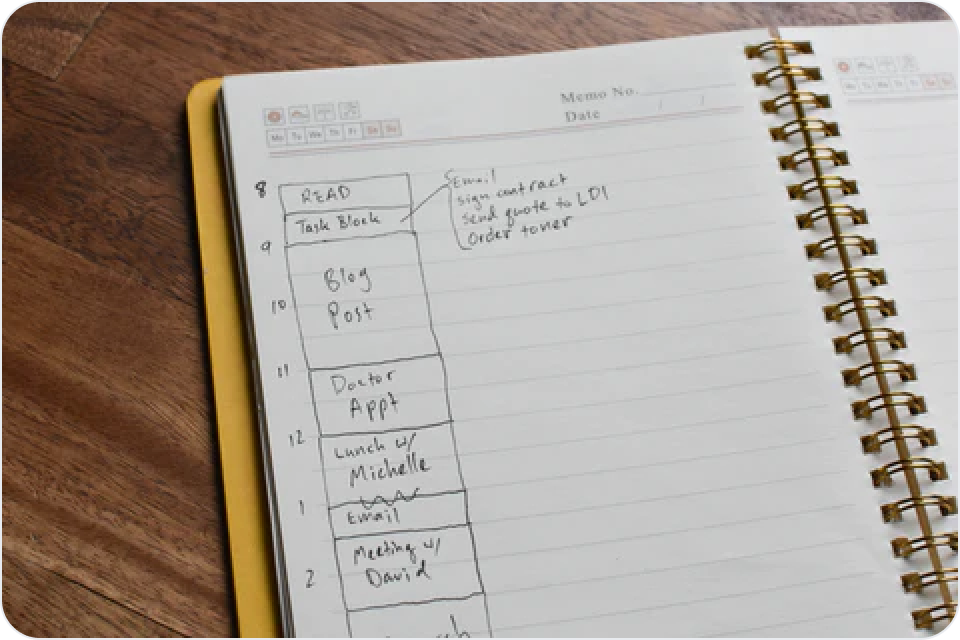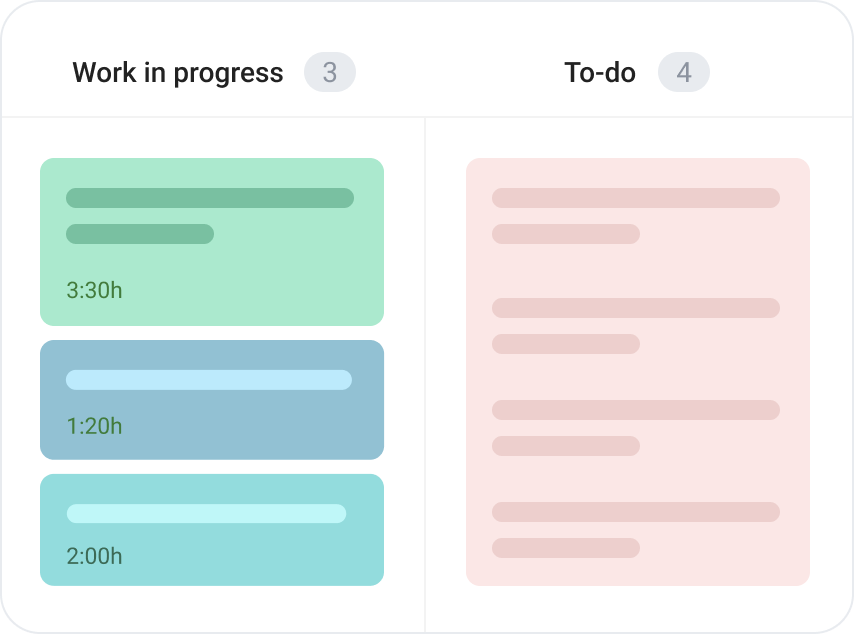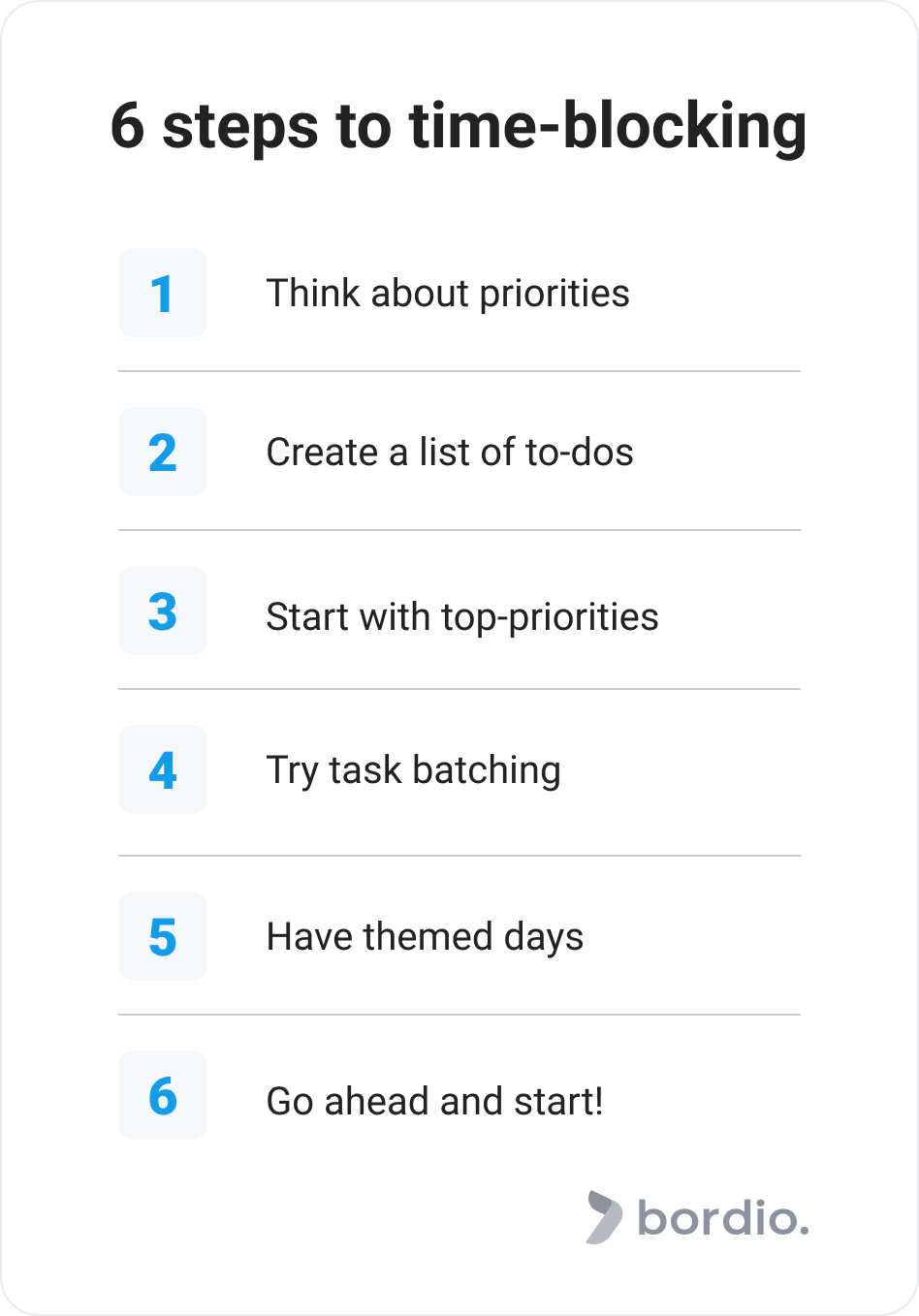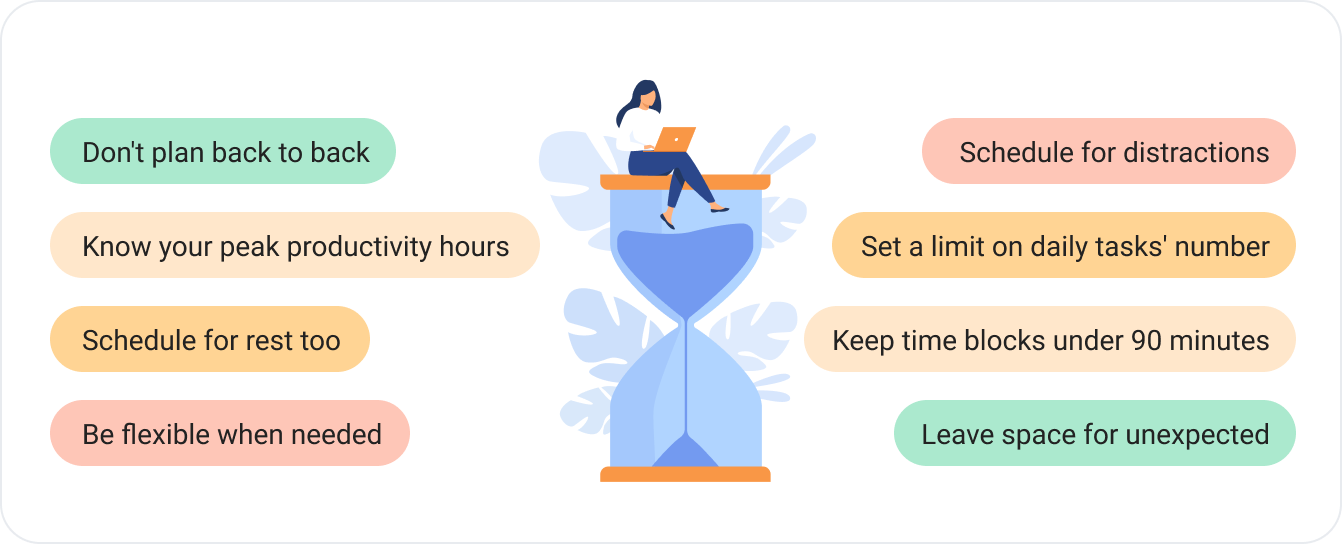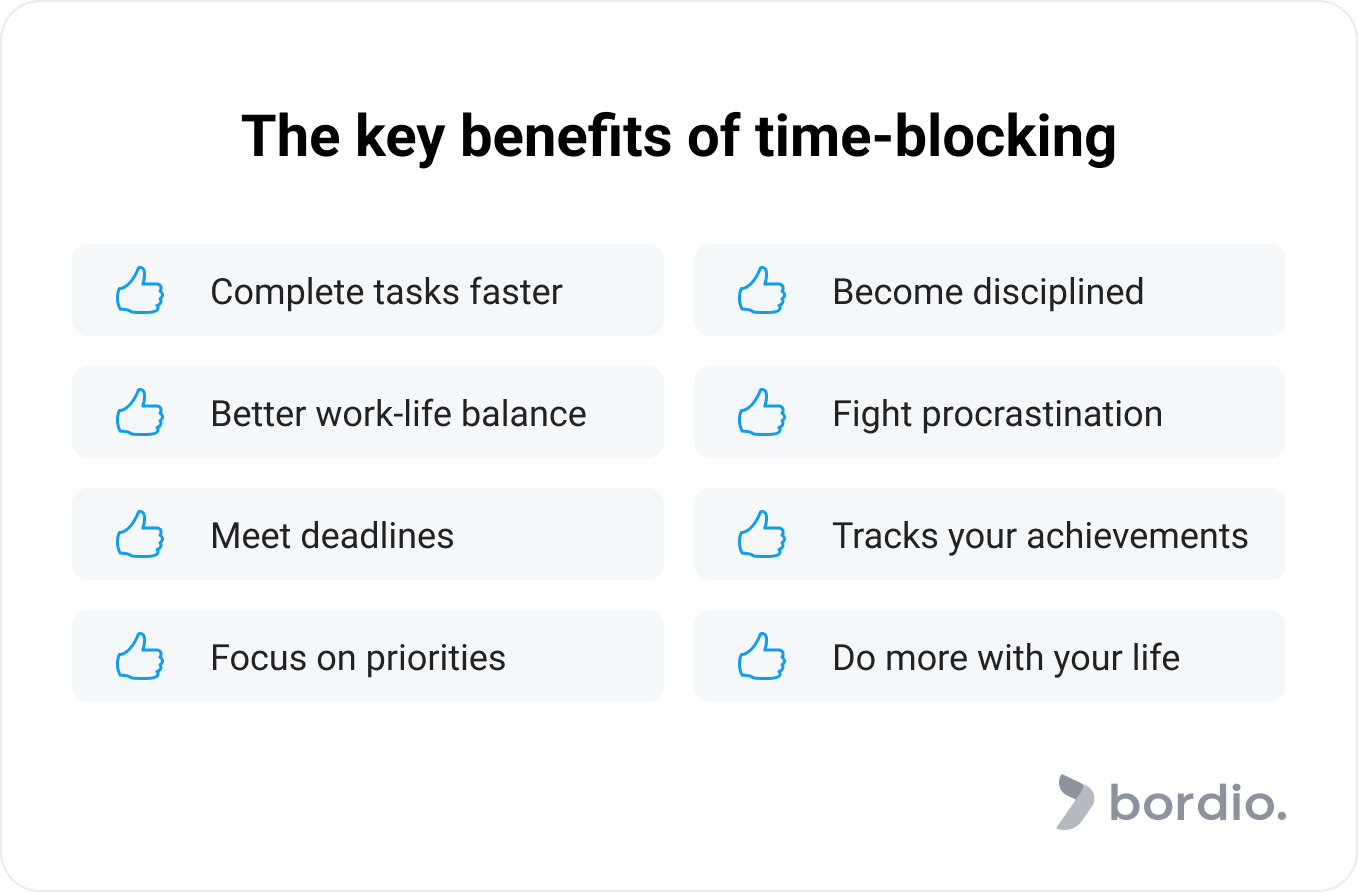If you’ve ever dived into the world of productivity lifehacks and time management tips, you’ve probably heard about time-blocking.
It is a tried-and-tested yet still niche technique for achieving more throughout your days. At Bordio, we can’t get enough of time-blocking and the benefits it brings to the team. That’s why today we will be talking about all things time-blocking: what it is, why everyone must try it, and how to make the most of it.
Curious? Then keep on reading!
The definition of time-blocking
Time-blocking is sometimes referred to as calendar blocking and is a time management technique focused on reserving chunks of time in your schedule to dedicate to a specific activity. The idea is that you focus fully on the task that is specified in your time block without any distractions to other things on your list or personal matters.
Unlike a simple to-do list in task trackers, time-blocking is a planning method that tells you both what you need to do and when you should do it.
How successful people use time-blocking
Time-blocking method is popular among successful people that we admire daily. Let’s look at some examples of time-blocking done by celebrities.
Cal Newport
Cal Newport, a renowned productivity guru and author of best-selling books, is a huge fan of time blocking. He likes to work with pen and paper and starts his day by drawing blocks of 30 minutes and planning out the list of things he needs to accomplish on that day.
Ps – learn more about Cal’s and other experts’ productivity tips in our best productivity books list.
Bill Gates
In one of the articles to the Telegraph, Gates shared that he uses time blocking meticulously no matter how long tasks take to complete. If a specific task takes five minutes, he will schedule a 5-minute time block in his daily planner.
Elon Musk
Another example of a professional time blocker is Elon Musk. Musk is famously busy with Tesla and SpaceX, plus he is working on several smaller projects and finds the time to be with his kids. Just like Gates, Musk can create as small as 5-minute increments of time in his time schedule maker.
Time-blocking vs. a to-do list
To an untrained eye, time-blocking and to-do lists in project management tools are the same. But in reality, they are not.
To-do lists are.. well, simply lists of things you need to do. They have no relation to the time and they offer zero task prioritization. As a result, you may have been busy cracking through low-priority tasks all day but accomplished nothing meaningful in the end.
With time blocking, you have a plan for the day that keeps you active and working towards your goals. A to-do list, in turn, is easy to ignore, and it doesn’t help with productivity or time management in any way.
Also, if we take a task and a time block – they would not be equal either. A time block is a period of time reserved to do something. And a single task can have multiple time blocks assigned to it.
How to start time-blocking
Now that you understand time-blocking a bit better and are motivated to start – how do you do that? We prepared a list of easy steps to take to embark on the time-blocking journey.
1 Sit down and think about your priorities
Identify what you want to be time blocked. Take the time to sit down and think through what your priorities are.
At the same time, don’t forget about lower priority but mandatory things (such as administrative tasks) that have to be completed too. Often we procrastinate on the mundane task that we have no motivation to work on but that still has to be done. If you ignore such tasks for too long, you will have a disaster at some point. Better incorporate them into your time-blocking schedule in time planner calendar and deal with them right away.
2 Create lists of everything you need to do
Come up with a to-do list in best virtual planner for the next day, a week, two weeks, or a month (choose the timeframe that you prefer) and make sure it includes all necessary tasks as well as your key priorities.
Also, please include both personal and work things.
The waiting list in Bordio is a perfect place to do a mind sweep (a.k.a. a brain dump). Write down all your ideas, thoughts, and tasks. Later, as you’ll be working with your weekly planner, you’ll be able to pick up the list and see what you can schedule and time block for the week.
3 Start scheduling from top-priority tasks
You can work on 100 tasks during the week, but if none of them are critical, then you will feel empty inside and dissatisfied with yourself. To prevent this from happening, choose the right online planner.
We recommend using Bordio online calendar planner for time blocking because this feature is already built-in and optimized for convenience. However, any calendar will do.
4 Give task batching a try
Consider task batching along with time-blocking. Task batching is when you group similar tasks to work on them more efficiently. For example, answering emails and sending proposals to clients are both quiet tasks that require the same energy. Making sales calls and finishing a research paper, on the other hand, are two completely different tasks and would not work for task batching. To make your task batching better you shold use work management software.
Context switching distracts you and reduces your productivity, so by focusing on similar tasks, you will have your time spent more efficiently.
5 Have themed days
Plan your week day by day in online weekly schedule planner. If you work on several projects, try having days when you focus on just one project. For example, Mondays and Wednesdays are for your startup, Tuesdays and Thursdays are for freelance jobs, and Fridays are for anything pending left for the week. When you focus on one area of your business or one project at a time, you get to dive deeper into them and progress with them faster.
Day theming also works if you only have one job sometimes. For example, as a CEO, you can dedicate days to hiring and HR in general, accounting and finance, and process optimization.
6 Start working with time blocks
Now that you’ve dedicated enough time to creating a structure, it’s time for action! Test out the new format, see what works and what doesn’t, and make necessary adjustments.
Tips for mastering the time-blocking method
Time-blocking is rather straightforward, but there are still ways you can make it more efficient. We prepared a list of time-blocking tips to help you complete all important tasks without spending an entire day doing them.
Don’t create time blocks back-to-back
Leave buffer time between the time blocks. One of your tasks may run over and mess up your entire day’s schedule. It is very common when you have meetings or wait to hear from someone to get extra information.
And if your schedule is not under any threat, use these 5-15 minutes between tasks to re-focus, move a little, get yourself a cup of coffee, or answer a personal message.
Understand your productivity
Figure out your peak productivity hours and use this knowledge to time block smart. You don’t have to be a member of the 5 am club if you really like to sleep late. Different people thrive in different circumstances.
Spend a week or two watching yourself closely and learn the best parts of the day to do deep work. Use this knowledge to optimize your planning.
Plan for rest
Create time blocks for breaks too. You can’t forget to rest especially when working as a team. It is possible to use remote worker management software in order to allocate time correctly, leaving time for rest. Have at least one meal break, such as lunch. Also, try to have at least one 15-20 minute break every couple of hours. You need rest to function properly and do focused work, so don’t let yourself down.
Know when to stick to your schedule and when to walk away
You can’t follow a schedule 100% of the time. Life happens. And when it does, stay flexible and re-adjust your day to accommodate new needs. If that means pushing specific tasks until the next week let it be. Fortunately many modern schedule builders are now flexible and let you change the schedule at any time.
Schedule time for distractions too
If you struggle with focus and reach for your phone one too many times during work, consider adding a time block for using your phone.
Call it a “Social Media break” and set up a 15-20 minutes block in the day. That way, you’ll know that you have dedicated time to scroll the networks, and you won’t miss out on new posts. With that, you’ll be able to focus on work more.
Try setting a limit on how many tasks you time block per day
Setting too many too-ambitious time blocks will only leave you dissatisfied and resentful.
Instead, have fewer tasks per day, and then if you work through them and still have energy, dive into your waiting list. The Ivy Lee Method is great for limiting your to-do list, so try using it if you struggle.
Don’t make your time blocks too long
Aim to have them no longer than 90 minutes because you’ll struggle with focus past that. If your task is demanding, schedule several blocks of time with breaks instead of a single big one.
Leave space for emergencies
If you work a 5-day workweek, consider only scheduling time blocks for four days out of five. Or you can create time blocks for the first half of the day (when our productivity and focus are best anyway) and leave evenings free for anything that may happen.
Bonus tip: Create an end-of-day routine to help signal your brain that it’s time to relax. For example, you can end each day with a 5-10 minute session where you look back at your calendar, see what you’ve accomplished and what is still pending, have a quick glance at tomorrow’s plan, or draft a schedule for the week ahead.
The key benefits of time-blocking
Before we move on to the details and nuances of time-blocking, let’s cover the key benefits that this productivity technique offers to us.
In short, it’s either you who is in control of your calendar, or your calendar is in control of your life. You choose.
Complete tasks faster
According to Parkinson’s law, work expands to fill the time available for its completion. One of the best real-life examples of this law in action is checking emails. You could do it in 10 minutes or you could spend two hours browsing through your inbox. All with the same outcome.
And why would you want to spend more time on things that could be done in half the time? Time-blocking allows you to do just that – optimize your time and have more freedom to do whatever you want besides the mandatory tasks.
Have a better work-life balance
Having a clear distinction between work and leisure is proven to make humans happier and more fulfilled.
Uncontrolled schedules and flexible working hours can do a disservice if you lose control of it. Instead, with time blocks, you have an understanding of when you should be working and when your time off is. As a result, you work when you’re supposed to, and you relax without guilt or anxiety.
Meet your deadlines
Maybe we are poor planners, or maybe we are optimists, but either way – people are notorious for underestimating how much time something will take. And when we fail to plan sufficient time for the job, you guessed it – we miss our deadlines.
And time blocks can help with that in three different ways:
- Usually, you would block the time to work on tasks prior to the deadline, for example, a week before something is due. And if you’re not done when the time block is up, you still have several days before the deadline, so you can squeeze in another time block to finish up the assignment.
- The second way time blocks can help us with meeting deadlines is that we actually leave out time to work on tasks. Reserved time in your calendar means you are less likely to forget there is a deadline at all. Because how many times have we remembered about a task 15 minutes before it was time to submit it? Too many to count!
- Time-blocking makes us better planners. If you do similar or repetitive work, every time you set time blocks and work through them, you get a better feel for how many hours the job actually takes. So, next time when you need to do the same task, you’ll be able to plan better from the start.
Focus on priority goals and targets
The exercise of time-blocking makes you work with your goals and plan for execution. That way, you are not constantly swamped with urgent but unimportant tasks that sadly tend to occupy our schedules.
Makes you more disciplined and focused
Say what you want, but working through a 1 or 2-hour session without distractions is hard. But the good news is that you can practice and train your focus. The more you do it – the better you become. Start working with time blocks and, before you know it, you’ll be a master of deep focus.
Reduce procrastination
One of the reasons we procrastinate is that we don’t have a plan to guide us.
In situations when there is so much to do that we feel overwhelmed and resort to going through shallow tasks or not doing anything at all. Such a reaction is more common than you think, and time-blocking is a wonderful way to fight it.
With time blocks, when you start your day by opening your calendar, you’ll see a detailed plan of what needs to be done that day. There won’t be decision-making necessary. You’ll already know where to start, and you will waste less time.
Keep a track record of your achievements
In today’s world, where everyone is focused on moving forward, it’s good to stop every once in a while and look back at your accomplishments. With time blocking, you’ll be able to see exactly what you’ve been doing and where your time was going. It will help you see how far you’ve come and be a bit kinder to yourself.
Find time for everything in your life
Feel like there are not enough hours in the day for you to start a hobby? Or, perhaps, you’re worried about not spending enough time with kids?
Book the time in your calendar to make sure your key priorities in life receive the treatment they deserve. Schedule fun stuff can seem weird at first, but it’s a game changer.
The secret behind time-blocking
Time-blocking is very efficient, and it gets better the more you practice it. The secret is simple – in order to create time blocks, one must review their to-dos and the calendar for the upcoming week. You need to review everything and prioritize tasks in order to plan accordingly.
Another reason for the great results that you can achieve with time-blocking is that it forces you to focus on one thing at a time.
Unlike the unhealthy and inefficient practice of multitasking, monotasking promotes complete focus, which results in fewer mistakes and a shorter timeframe that it takes to complete the task.
Instead of jumping from one job to another, you initiate a deep work session and manage to do much more in the same amount of hours.
The signs you need time-blocking in your life
Time-blocking is not the only time management method out there, but it is highly effective.
Here are seven signs that you need a time-blocking method in your life:
- You constantly feel like you are running behind your schedule.
- You do a lot of work but nothing meaningful seems to get done.
- You can hardly remember the last time you were able to sit down and think strategically about the direction you’re going in.
- You catch yourself multitasking a lot.
- You feel like you don’t have a life outside of work.
- You feel that your productivity has been declining over time.
- You want to achieve more but fail to see how that can be done.
Disclaimer: Time-blocking is a powerful technique, but it’s not for everyone. Some jobs are just not made for this method, and that’s okay. You can still try and implement time-blocking in some way into your life, be it for only a part of your job, your personal time, or your education.
Final thoughts on time-blocking
Time-blocking is a wonderful time management technique that will help you get ahead in life if you let it. There are many time-blocking variations out there, so don’t worry if you’re not happy with the classic approach. Feel free to play with it and make it yours.
After all, it’s your life, and your productivity is at stake, so experiment and see what works for you!
Also, remember that time-blocking forces you to focus on the key priorities, and it can also guide you, but it will not do the work instead of you. So, as you implement this technique in your daily life, prepare to put in the effort and give yourself time to re-adjust your working habits.

